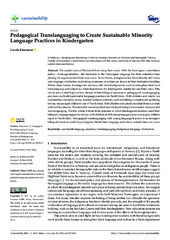Pedagogical Translanguaging to Create Sustainable Minority Language Practices in Kindergarten
Permanent link
https://hdl.handle.net/10037/20788Date
2021-03-24Type
Journal articleTidsskriftartikkel
Peer reviewed
Author
Kleemann, CarolaAbstract
The coastal areas of Finnmark have deep Sámi roots. With the Norwegian assimilation policy—Norwegianization—the transition to the Norwegian language has been extensive here, placing the region outside Sámi core areas. Nevertheless, indigenous Sea Sámi identity still exists, and language vitalization and raising awareness of culture are shown in Sámi institution building. Within these frames, kindergarten teachers with Sámi backgrounds work to strengthen their local Sámi language and culture in a Sámi department of a kindergarten outside the core Sámi areas. This article aims to shed light on how the use of their bilingual resources in pedagogical translanguaging practices can build sustainable language practices for North Sámi. With children and adults, we explored how culturally aware, situated outdoors activities, such as building a campfire and gathering berries, encouraged children’s use of North Sámi. Both children and adults recorded these activities with GoPro cameras. The material was transcribed and analyzed using Conversation Analysis and translanguaging. For this article, I chose three episodes in which kindergarten teachers used their bilingual language register to interact with children in different pedagogical practices to give children input in North Sámi. Pedagogical translanguaging with young language learners in an emergent bilingual situation could help strengthen North Sámi language and culture outside Sámi core areas.
Publisher
MDPICitation
Kleemann CB. Pedagogical Translanguaging to Create Sustainable Minority Language Practices in Kindergarten . Sustainability. 2021;13(7)Metadata
Show full item recordCollections
Copyright 2021 The Author(s)


 English
English norsk
norsk